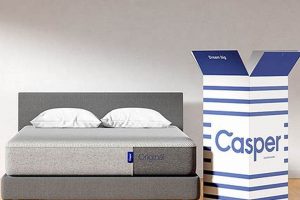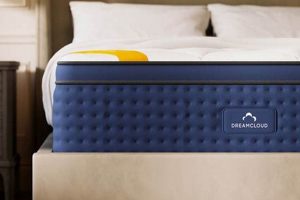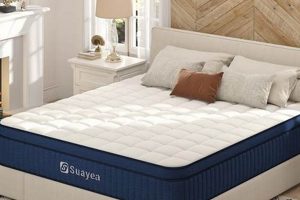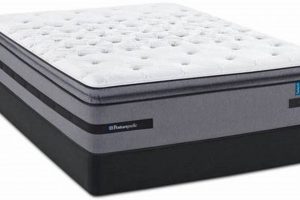A large sleeping surface, often wider than a standard queen size, offers enhanced personal space and reduces partner disturbance during sleep. This type of mattress aims to provide ample room for individuals or couples who desire more sprawling comfort. It’s designed to improve sleep quality through increased freedom of movement.
Such mattresses are particularly beneficial for restless sleepers, couples with different sleep schedules, or individuals who simply value the extra space. Historically, the availability of larger mattresses has grown alongside increasing consumer demand for higher levels of comfort and individualized sleep solutions. Their impact is significant, as better sleep contributes to improved overall health and well-being.
The following sections will delve into the specific features, construction materials, and selection criteria associated with choosing an appropriate oversized sleeping platform to maximize rest and rejuvenation.
Guidance for Optimal Selection
The following guidance aids in selecting a sleeping solution maximizing comfort and promoting restorative rest. These recommendations focus on objective factors influencing sleep quality and long-term product satisfaction.
Tip 1: Assess Dimensional Requirements: Measure the intended bedroom space to ensure the sleeping surface fits without obstructing movement or access to other furniture. Consider the overall room layout before purchase.
Tip 2: Evaluate Material Composition: Examine the layers within the mattress. Density and type of foam (memory, latex, hybrid), coil count (if applicable), and fabric covering are vital factors affecting support, temperature regulation, and durability.
Tip 3: Consider Support Needs: Determine individual or combined body weight and sleeping position(s) to select an appropriate firmness level. A firmer surface generally suits back and stomach sleepers, while softer surfaces accommodate side sleepers.
Tip 4: Review Edge Support Construction: Robust edge support prevents sagging and provides a consistent sleeping surface across the entire mattress width. Strong edge support also facilitates sitting on the edge without significant compression.
Tip 5: Investigate Temperature Regulation Properties: Look for materials and construction methods designed to dissipate heat. Open-cell foams, breathable fabrics, and gel infusions can minimize overheating and promote comfortable sleep.
Tip 6: Research Foundation Compatibility: Verify the suitability of the chosen foundation (box spring, platform, adjustable base) to ensure proper support and prevent premature wear. Consult the manufacturer’s recommendations.
Tip 7: Review Trial Periods and Warranties: Opt for a product offering a reasonable trial period to assess comfort and suitability. Understand the warranty terms covering manufacturing defects and potential issues.
Adhering to these recommendations contributes to informed decision-making, yielding a sleeping surface that optimally supports individual sleep needs and preferences.
The subsequent section elaborates on the long-term maintenance and care procedures to ensure the longevity of the chosen mattress.
1. Dimensions
Dimensional considerations are paramount when evaluating an oversized mattress. The physical size directly impacts suitability within a bedroom, influencing overall comfort and usability. Optimal dimension selection balances ample sleeping space with spatial constraints within the room.
- Room Size Compatibility
The primary consideration is ensuring the mattress fits within the bedroom without obstructing movement or access to other furniture. Overly large mattresses in smaller rooms can lead to a cramped and uncomfortable environment. Precise measurements of the room and mattress are essential for effective space planning.
- Sleeping Surface Area
Oversized mattresses provide a significantly larger sleeping surface compared to standard sizes. This increased area allows for greater freedom of movement during sleep and reduces the likelihood of partner disturbance. The degree of enhanced space is a key factor in selecting the appropriate mattress size.
- Foundation and Frame Requirements
Specific foundation and frame dimensions are necessary to properly support the mattress. Standard-sized frames may be inadequate, requiring specialized support systems to prevent sagging or damage. Matching the foundation dimensions to the mattress dimensions ensures optimal structural integrity and extends the product’s lifespan.
- Accessibility and Maneuverability
The size of an oversized mattress can present challenges during delivery and setup. Narrow hallways, stairwells, or doorways may impede access, necessitating careful planning and potentially specialized delivery services. Considering these logistical factors is essential prior to purchase.
The interplay of these dimensional facets directly influences the suitability of an oversized mattress. Prioritizing careful measurement and evaluation of spatial constraints ensures the chosen product enhances, rather than detracts from, the overall sleep environment.
2. Support
Support is a critical determinant in the overall comfort and suitability of an oversized mattress. It dictates spinal alignment, pressure distribution, and ultimately, the quality of sleep. Adequate support prevents sinking, ensures proper posture, and minimizes potential back pain.
- Core Construction and Stability
The internal structure of a larger mattress must provide consistent support across its extended surface. This often involves a combination of high-density foams, strategically placed coils, or reinforced internal support systems. A robust core prevents sagging, particularly in the center, and ensures uniform weight distribution. For example, a pocketed coil system in a hybrid design can offer targeted support to different body zones.
- Edge Support Reinforcement
Due to their increased size, oversized mattresses require enhanced edge support to prevent roll-off and maximize the usable sleeping surface. Reinforced edges, typically achieved through high-density foam encasements or additional coil rows, provide a stable perimeter that resists compression and maintains a consistent sleep surface from edge to edge. Strong edge support also facilitates sitting on the edge of the bed without significant sinking.
- Weight Distribution and Accommodation
Support mechanisms must accommodate varying body weights and sleeping positions effectively. Targeted support zones, often incorporated through varying foam densities or coil gauges, cater to specific areas of the body, such as the lumbar region or shoulders. This ensur
es proper spinal alignment regardless of the sleeper’s position. Couples with significant weight differences require mattresses capable of evenly distributing weight and minimizing motion transfer. - Foundation Compatibility and Structural Integrity
The foundation plays a crucial role in providing overall support. Oversized mattresses necessitate robust foundations capable of bearing the additional weight and preventing structural failure. Platform beds, reinforced box springs, or adjustable bases are common choices, each contributing to the mattress’s long-term stability and preventing premature sagging. Incompatible foundations can compromise the support system and void warranties.
These interlinked aspects of support are indispensable for maximizing comfort and longevity. A properly supported oversized mattress promotes spinal alignment, reduces pressure points, and ensures a restful sleep experience, while extending the lifespan of the mattress itself. Compromising on support can negate the benefits of increased sleeping space.
3. Materials
Material selection directly influences the overall performance, comfort, and longevity of an oversized mattress. The composition of its constituent layers dictates support, temperature regulation, and resistance to wear. Informed material assessment is, therefore, essential for maximizing long-term satisfaction.
- Foam Density and Composition
Foam layers within the mattress, whether memory foam, latex, or polyurethane, provide cushioning and contouring. Density, measured in pounds per cubic foot (PCF), directly affects support and durability. Higher-density foams resist compression and maintain their shape over time, offering consistent support and reducing the likelihood of sagging. Material composition, such as the use of open-cell structures in memory foam or natural latex, enhances breathability and temperature regulation. For example, a 5 PCF memory foam layer offers significantly greater support and longevity compared to a 3 PCF variant.
- Coil Type and Gauge
In hybrid mattresses, the coil system provides primary support and responsiveness. The type of coil, such as pocketed coils or interconnected coils, influences motion isolation and contouring. Pocketed coils, individually wrapped in fabric, minimize motion transfer and allow for independent compression, conforming to individual body contours. Coil gauge, a measure of wire thickness, affects firmness and support. Lower gauge numbers indicate thicker coils and greater firmness. For example, a 13-gauge coil provides a firmer sleeping surface than a 15-gauge coil.
- Cover Fabric and Breathability
The cover fabric directly impacts airflow and temperature regulation. Materials like cotton, bamboo, or specialized performance fabrics enhance breathability, wicking away moisture and promoting a cooler sleep environment. Tightly woven fabrics offer greater durability but may restrict airflow. For example, a cover fabric incorporating phase change materials can regulate temperature by absorbing and releasing heat.
- Adhesives and Flame Retardants
Adhesives bind the mattress layers together, while flame retardants meet safety standards. The types of adhesives and flame retardants used can impact air quality and potential off-gassing. Low-VOC (volatile organic compound) adhesives and naturally derived flame retardants, such as silica or wool, minimize potential health concerns. Transparency regarding the composition of these materials is essential for informed consumer choice.
Understanding these material attributes allows for the selection of an oversized mattress tailored to individual preferences and needs. Prioritizing high-quality materials contributes to enhanced comfort, durability, and overall sleep quality. Its important to research and compare specifications to make informed decisions that align with personal requirements.
4. Temperature Regulation
Temperature regulation is a critical factor influencing sleep quality on an oversized mattress. The capacity of the sleeping surface to dissipate heat and maintain a comfortable microclimate significantly impacts the ability to achieve restorative rest. The expansive surface area inherent in a large mattress necessitates effective temperature management strategies.
- Material Breathability
The breathability of mattress materials, particularly the cover fabric and comfort layers, directly affects airflow and heat dissipation. Fabrics like cotton, bamboo, or open-weave performance materials promote air circulation, wicking away moisture and preventing heat build-up. The density and structure of foam layers also play a role; open-cell foams allow for greater airflow compared to closed-cell variants. For instance, a mattress featuring a breathable knit cover and open-cell memory foam provides superior temperature regulation compared to one with a tightly woven synthetic cover and dense, non-breathable foam. The enhanced breathability minimizes the likelihood of overheating, promoting a more comfortable sleep environment.
- Heat Dissipation Technologies
Advanced mattress designs incorporate specific technologies to enhance heat dissipation. Gel-infused foams, phase-change materials (PCMs), and copper-infused components are commonly used to regulate temperature. Gel infusions absorb heat, while PCMs store and release heat to maintain a consistent temperature range. Copper possesses inherent thermal conductivity, drawing heat away from the body. These technologies contribute to a cooler sleeping surface, reducing the incidence of night sweats and promoting uninterrupted sleep. For example, a mattress incorporating copper-infused memory foam effectively dissipates body heat, preventing temperature spikes during the night.
- Airflow Channels and Ventilation
Some mattresses feature internal airflow channels or ventilation systems designed to enhance circulation and prevent heat accumulation. These channels, often incorporated within the foam layers or around the perimeter of the mattress, create pathways for air to flow, dissipating heat and moisture. Edge support systems constructed with breathable materials also contribute to overall ventilation. This enhanced airflow minimizes the risk of overheating, particularly in warmer climates or for individuals prone to night sweats. As an example, a mattress with ventilated edge support and strategically placed airflow channels promotes continuous air circulation, maintaining a cooler and more comfortable sleeping surface.
- Impact of Foundation Type
The type of foundation used in conjunction with the mattress also influences temperature regulation. Solid platform beds can restrict airflow, potentially trapping heat beneath the mattress. Slatted foundations or adjustable bases with breathable mesh surfaces promote better ventilation, allowing heat to dissipate more effectively. Choosing a foundation that allows for adequate airflow is essential for maximizing the temperature regulation benefits of the mattress. For example, pairing a breathable mattress with a slatted foundation enhances overall ventilation, creating a cooler and more comfortable sleep environment compared to using a solid platform base.
Effective temperature regulation is paramount for op
timizing sleep quality on a large mattress. By prioritizing breathable materials, heat dissipation technologies, and proper ventilation, the potential for overheating is minimized, promoting a comfortable and restorative sleep experience. The interplay of these factors contributes to a sleep surface that adapts to individual temperature preferences, enhancing overall sleep satisfaction. It ensures that the benefits of an oversized mattress are not negated by discomfort due to heat retention.
5. Edge Support
In oversized mattresses, such as a comfort king mattress, edge support is a structural design element crucial for maximizing the usable sleeping surface and ensuring long-term durability. Without adequate edge reinforcement, the perimeter of the mattress is prone to compression and sagging, effectively reducing the available sleeping area and potentially leading to discomfort. The increased surface area of a comfort king amplifies the impact of inadequate edge support, making it a significant factor influencing overall mattress performance. The effect is that individuals who sleep near the edge may experience a sensation of rolling off, while those sitting on the edge may encounter significant compression, making activities like dressing or reading uncomfortable.
The integration of robust edge support mechanisms, such as high-density foam encasements or reinforced coil systems along the perimeter, directly addresses these issues. These features provide a stable and consistent sleeping surface across the entire mattress width, preventing localized compression and maintaining structural integrity over time. Consider a scenario where two individuals of differing weights share a comfort king mattress; effective edge support ensures that both individuals can comfortably utilize the full width of the mattress without experiencing a significant difference in support or contouring. Practically, this means that the sleeper nearest the edge is not relegated to a less supportive, sloping surface.
Ultimately, edge support is an integral component of a well-designed comfort king mattress, contributing directly to enhanced comfort, increased usable space, and extended lifespan. Deficiencies in edge support diminish the intended benefits of the larger sleeping surface, potentially leading to premature wear and reduced user satisfaction. Therefore, assessing the quality of edge support is essential when selecting a comfort king mattress to ensure optimal long-term performance and value.
6. Durability
The durability of a comfort king mattress directly influences its long-term value and cost-effectiveness. Given the considerable investment involved in acquiring an oversized mattress, its ability to withstand prolonged use without significant degradation is of paramount importance. A comfort king mattress experiencing premature sagging or material breakdown compromises its intended function, leading to diminished comfort and support. The expansive surface area of a comfort king places greater demands on its construction, making material selection and structural integrity critical determinants of its overall lifespan.
The connection between durability and a comfort king mattress is exemplified by examining the types of materials used in its construction. High-density foams, robust coil systems, and reinforced edge supports contribute significantly to a mattress’s ability to maintain its shape and support over time. Conversely, lower-quality materials, such as low-density foams or poorly constructed coil systems, are more susceptible to compression and breakdown, resulting in premature sagging and reduced comfort. A comfort king mattress utilized by a couple with varying weights, for instance, necessitates durable components capable of accommodating differing pressure points without experiencing localized degradation. The choice of materials directly impacts the mattress’s capacity to provide consistent support and comfort throughout its lifespan.
In conclusion, durability represents a fundamental attribute of a comfort king mattress. Its influence spans from ensuring consistent comfort and support to safeguarding the long-term value of the investment. By carefully considering material composition, construction methods, and structural reinforcements, consumers can select a comfort king mattress designed to withstand prolonged use and maintain its intended performance characteristics over an extended period. Prioritizing durability ensures the mattress continues to provide restful and supportive sleep for years to come, thereby maximizing its practical significance and overall value proposition.
7. Foundation
The foundation serves as the bedrock for a comfort king mattress, providing essential support and influencing its overall performance and longevity. Selecting an appropriate foundation is not merely an afterthought but a crucial element in optimizing the comfort and lifespan of a substantial mattress.
- Structural Support and Weight Distribution
The primary role of a foundation is to evenly distribute the weight of the mattress and its occupants. A comfort king, due to its increased size and potential for accommodating multiple sleepers, places significant stress on its support structure. An inadequate foundation can lead to localized sagging, uneven wear, and premature degradation of the mattress. Platform beds with closely spaced slats, reinforced box springs, or adjustable bases designed for heavier loads are typical choices that can provide the necessary structural integrity. For instance, a poorly constructed box spring may fail under the weight of a comfort king mattress and two adults, leading to indentations and a compromised sleep surface.
- Impact on Mattress Performance and Comfort
The type of foundation directly affects the firmness and feel of the mattress. A solid platform bed offers a firmer feel compared to a traditional box spring, which provides a degree of flex. The foundation must complement the mattress’s design to deliver the intended level of comfort and support. Pairing a firm mattress with a rigid foundation may result in an uncomfortably hard sleeping surface, while a soft mattress on a yielding foundation may lack sufficient support. Adjustable bases further complicate the equation, requiring careful consideration of the mattress’s flexibility and compatibility with the base’s articulation points.
- Ventilation and Airflow Considerations
The foundation’s design influences airflow around the mattress, impacting temperature regulation. Solid platform beds can restrict airflow, potentially trapping heat and moisture. Slatted foundations or open-design adjustable bases promote better ventilation, allowing the mattress to breathe and dissipate heat more effectively. Proper ventilation is particularly important for mattresses containing materials prone to heat retention, such as memory foam. A comfort king mattress placed on a solid platform may become uncomfortably warm, especially in warmer climates or for individuals prone to night sweats.
- Warranty Compliance and Mattress Protection
Many mattress manufacturers specify foundation requirements to maintain warranty coverage. Using an incompatible foundation can
void the warranty, leaving the consumer responsible for repair or replacement costs. The foundation also provides a physical barrier between the mattress and the floor, protecting it from dirt, dust, and potential damage. Selecting a foundation that meets the manufacturer’s specifications and provides adequate protection is essential for safeguarding the mattress investment and ensuring long-term peace of mind. Failing to adhere to these specifications can result in the warranty being invalidated, leaving the owner liable for potential repairs or replacements.
In essence, the foundation is not merely an accessory but an integral component of the sleep system. Its role in providing support, influencing comfort, facilitating ventilation, and maintaining warranty compliance cannot be overstated. When selecting a comfort king mattress, careful consideration must be given to choosing a foundation that aligns with the mattress’s design, meets the manufacturer’s specifications, and fulfills the individual’s needs for comfort and support.
Frequently Asked Questions
The following addresses common inquiries regarding the selection, care, and suitability of oversized mattresses, providing clarification based on objective assessments.
Question 1: What are the typical dimensions of a comfort king mattress, and how do they differ from standard sizes?
A comfort king mattress generally measures approximately 80 inches in width and 78 inches in length. This contrasts with a standard king mattress, which typically measures 76 inches in width and 80 inches in length. Queen mattresses are significantly smaller, usually measuring 60 inches in width and 80 inches in length.
Question 2: What factors should be considered when assessing the suitability of a comfort king mattress for a specific bedroom?
Consideration should be given to room dimensions, allowing for adequate space around the mattress for movement and furniture placement. Doorway widths and hallway dimensions must also be assessed to ensure ease of delivery and setup. A minimum of two feet of clearance around the bed is generally recommended.
Question 3: How does the weight of a comfort king mattress compare to that of smaller mattress sizes, and what implications does this have for foundation selection?
Comfort king mattresses, due to their larger size and increased material volume, typically weigh more than smaller mattresses. This necessitates the selection of a robust foundation capable of supporting the increased weight without compromising structural integrity. Reinforced box springs, platform beds with closely spaced slats, or adjustable bases designed for heavier loads are recommended.
Question 4: What are the primary benefits of a comfort king mattress compared to smaller sizes?
The primary benefit is increased sleeping space, allowing for greater freedom of movement and reduced partner disturbance. This can be particularly advantageous for couples with different sleep schedules, restless sleepers, or individuals who prefer to sprawl out while sleeping.
Question 5: What are the recommended cleaning and maintenance procedures for a comfort king mattress?
Regular vacuuming is recommended to remove dust and allergens. Stains should be treated promptly with appropriate cleaning solutions, following the manufacturer’s instructions. Rotating the mattress periodically can promote even wear and extend its lifespan. The use of a mattress protector is strongly advised to prevent spills and stains from penetrating the mattress.
Question 6: What are the potential drawbacks of a comfort king mattress?
Potential drawbacks include the increased cost compared to smaller mattress sizes, the logistical challenges associated with delivery and setup, and the need for larger sheets and bedding. The increased size may also make it unsuitable for smaller bedrooms.
In summary, selecting a comfort king mattress necessitates careful evaluation of spatial constraints, weight-bearing capacities, and individual sleep preferences. Adhering to recommended maintenance procedures is crucial for maximizing its lifespan.
The subsequent section will present a summary of key considerations when purchasing a comfort king mattress.
Conclusion
The preceding analysis has examined the multifaceted aspects of the comfort king mattress. This exploration has underscored critical factors influencing purchasing decisions, encompassing dimensional suitability, support mechanisms, material composition, temperature regulation, edge reinforcement, durability considerations, and foundation compatibility. Addressing common inquiries and providing maintenance guidelines serves to equip prospective buyers with the information necessary for informed selection.
The selection of a sleep surface represents a significant investment in personal well-being. Prioritizing objective assessments and considering individual needs when choosing a comfort king mattress ensures the maximization of comfort and the attainment of restful, restorative sleep. Continued advancements in sleep technology will undoubtedly refine the available options, necessitating ongoing evaluation to determine the most appropriate solutions for individual requirements.







